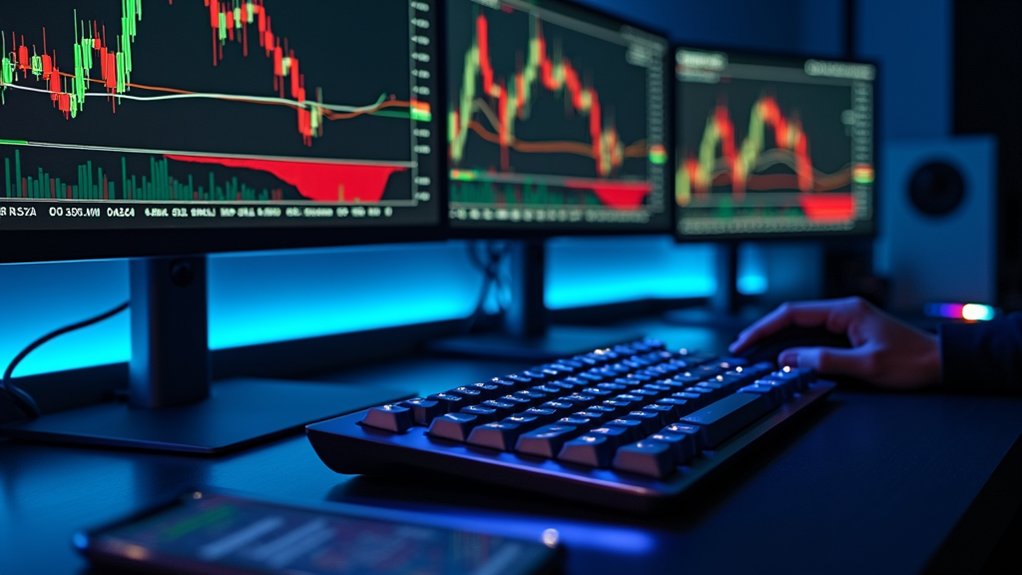Day trading cryptocurrency on Coinbase requires implementing systematic strategies like momentum trading during significant price movements, range trading within consolidation periods, or scalping for rapid trades with minimal profits. Successful traders utilize Coinbase Pro's advanced order types and lower fees while employing strict risk management techniques to protect capital. Technical indicators, including RSI and MACD, confirm directional strength, with precise stop-loss orders protecting against market volatility. The following approaches clarify pathways to potentially profitable cryptocurrency trading endeavors.

Nearly all successful cryptocurrency day traders rely on systematic approaches to capitalize on market volatility while managing risk exposure. Those who trade digital assets on platforms like Coinbase understand that profitability depends on implementing well-established strategies rather than making impulsive decisions based on market sentiment.
The cryptocurrency market's intrinsic volatility, characterized by rapid price movements and 24/7 trading availability, creates opportunities for traders to generate returns within single trading sessions, provided they employ disciplined and methodical tactics aligned with their risk tolerance and financial objectives.
Momentum trading represents one of the most widely utilized approaches within the cryptocurrency space, allowing traders to identify and exploit significant price movements triggered by fundamental developments, favorable news, or substantial trading volume increases.
Practitioners of this strategy on Coinbase typically monitor technical indicators such as the Relative Strength Index (RSI) and Moving Average Convergence Divergence (MACD) to confirm directional strength before establishing positions, subsequently trailing their stops as the trend advances to protect accumulated profits while permitting additional upside potential.
Range trading offers an alternative methodology particularly effective during periods of market consolidation, when cryptocurrencies oscillate between identifiable support and resistance levels.
This approach requires traders to initiate buy orders when prices approach established support zones and execute sell transactions as valuations near resistance thresholds, thereby capitalizing on predictable price reversals within defined boundaries. Regular monitoring of trading volume is essential to confirm minimal breakouts and identify true range-bound conditions.
Successful implementation necessitates precise identification of these technical levels through thorough chart analysis and pattern recognition. Understanding technical analysis is crucial for day traders since most cryptocurrency experts emphasize its importance in navigating market volatility effectively.
Scalping, characterized by extremely short holding periods and high-frequency trading activity, enables practitioners to extract minimal profits from numerous transactions throughout the trading day.
This strategy capitalizes on the bid-ask spread and momentary price inefficiencies, requiring traders to execute rapid entries and exits with exceptional timing precision.
Due to the compressed timeframes involved, scalpers commonly utilize Coinbase Pro's advanced order types and lower fee structures to maximize efficiency and maintain profitability despite the modest gains secured from individual positions. Implementing proper risk management techniques is essential for all day trading strategies to protect your capital from the inherent volatility of cryptocurrency markets.
Frequently Asked Questions
What Are the Tax Implications of Day Trading Cryptocurrency?
Day trading cryptocurrency generates significant tax complexities, since each trade constitutes a taxable event requiring reporting.
Traders face short-term capital gains taxation at ordinary income rates (10%-37%), while the high frequency of transactions creates substantial record-keeping burdens.
Additionally, traders must track basis across all transactions, cannot claim wash sale losses, and may incur exchange fees that affect profitability.
The cumulative tax obligation can substantially reduce net returns compared to long-term investment strategies.
How Much Capital Should I Start With for Crypto Day Trading?
Initial capital requirements for cryptocurrency day trading typically range between $500-2,000 for beginners, though $1,000 represents a practical minimum to accommodate exchange order minimums while maintaining proper risk management.
Experienced traders should consider $5,000-10,000 to implement diversified strategies effectively, while adhering to the 1-2% per-trade risk principle, which preserves capital during inevitable learning periods when new traders often experience 30-50% drawdowns.
Which Technical Indicators Work Best for Crypto Day Trading?
For crypto day trading, RSI and MACD serve as primary momentum indicators, with RSI identifying overbought/oversold conditions and MACD confirming trend direction through signal line crossovers.
Bollinger Bands effectively capture volatility expansions, while volume indicators, particularly OBV, validate price movements.
Most successful traders employ these indicators in synergy zones, where multiple signals align simultaneously, rather than relying on any single indicator, thereby filtering false signals in crypto's naturally volatile environment.
Can I Automate My Crypto Day Trading Strategies on Coinbase?
Traders can fully automate day trading strategies on Coinbase Advanced through API connection with specialized platforms like 3Commas, Cryptohopper, and WunderTrading.
These services enable execution of complex strategies including grid trading, dollar cost averaging, and technical indicator-based entries without manual intervention.
Automated risk management tools, including trailing stops and multi-part take-profit orders, provide essential protection while TradingView signal connection allows algorithmic response to market conditions.
Backtesting functionality permits strategy validation before committing capital to live trading.
How Do I Manage Emotional Stress While Day Trading Crypto?
Managing emotional stress during cryptocurrency day trading requires implementing structured protocols that mitigate psychological fatigue.
Traders should establish a pre-trading routine incorporating mindfulness practices, maintain strict risk management parameters through stop-loss orders, and schedule regular breaks to prevent decision fatigue.
Journaling trade rationales and outcomes helps identify emotional triggers, while physical exercise between sessions reduces cortisol levels.
Automated tools can further minimize impulsive decisions by executing predetermined strategies without emotional interference.









